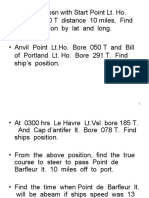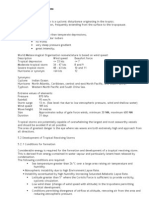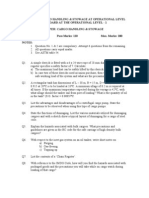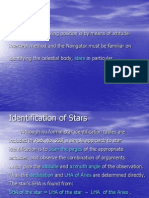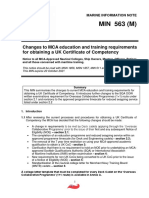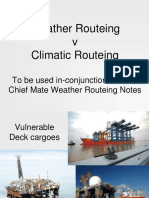67%(3)67% found this document useful (3 votes)
730 viewsCo Tidal Charts
Co Tidal Charts
Uploaded by
Ben KleinCo-tidal calculations are used to predict tidal information for deep drafted vessels in offshore areas where under keel clearance is marginal. Co-tidal and co-range charts show lines connecting points of equal mean high water interval and mean spring range. Standard ports are used as reference points to determine time corrections and height ratios needed to estimate tide times and levels from the standard port predictions. Care must be taken when positions lie on opposite sides of the 0 hour co-tidal line.
Copyright:
© All Rights Reserved
Available Formats
Download as PPT, PDF, TXT or read online from Scribd
Co Tidal Charts
Co Tidal Charts
Uploaded by
Ben Klein67%(3)67% found this document useful (3 votes)
730 views14 pagesCo-tidal calculations are used to predict tidal information for deep drafted vessels in offshore areas where under keel clearance is marginal. Co-tidal and co-range charts show lines connecting points of equal mean high water interval and mean spring range. Standard ports are used as reference points to determine time corrections and height ratios needed to estimate tide times and levels from the standard port predictions. Care must be taken when positions lie on opposite sides of the 0 hour co-tidal line.
Original Description:
Co Tidal Charts
Copyright
© © All Rights Reserved
Available Formats
PPT, PDF, TXT or read online from Scribd
Share this document
Did you find this document useful?
Is this content inappropriate?
Co-tidal calculations are used to predict tidal information for deep drafted vessels in offshore areas where under keel clearance is marginal. Co-tidal and co-range charts show lines connecting points of equal mean high water interval and mean spring range. Standard ports are used as reference points to determine time corrections and height ratios needed to estimate tide times and levels from the standard port predictions. Care must be taken when positions lie on opposite sides of the 0 hour co-tidal line.
Copyright:
© All Rights Reserved
Available Formats
Download as PPT, PDF, TXT or read online from Scribd
Download as ppt, pdf, or txt
67%(3)67% found this document useful (3 votes)
730 views14 pagesCo Tidal Charts
Co Tidal Charts
Uploaded by
Ben KleinCo-tidal calculations are used to predict tidal information for deep drafted vessels in offshore areas where under keel clearance is marginal. Co-tidal and co-range charts show lines connecting points of equal mean high water interval and mean spring range. Standard ports are used as reference points to determine time corrections and height ratios needed to estimate tide times and levels from the standard port predictions. Care must be taken when positions lie on opposite sides of the 0 hour co-tidal line.
Copyright:
© All Rights Reserved
Available Formats
Download as PPT, PDF, TXT or read online from Scribd
Download as ppt, pdf, or txt
You are on page 1of 14
Co-Tidal Calculations
Why use co-tidal calculations?
• For certain deep drafted vessels it may be
necessary to predict tidal information for a
specific time in offshore areas where UKC
is marginal.
• This information comes from Co-Tidal and
Co-Range Charts
Co-Tidal and Co-Range Charts
• Co-tidal lines are drawn through points of
Mean High Water Interval (MHWI)
• MHWI is defined as the mean time interval
between the passage of the Moon over
the Meridian of Greenwich and the time of
the next high water at the place
concerned
Where do you get co-tidal
information from?
• Co-range lines are drawn through points
of Mean Spring Range (MSR)
• MSR is defined as the difference in level
between Mean High Water Springs and
Mean Low Water Springs
Example of a co-tidal and co-range lines
Co-range lines (5m, 4m, 3m,
etc.) are drawn through
positions of equal Mean
Spring Range
Values of MHWI and MSR
are also given for a
number of Standard Ports Amphidromic Point
Where the range of
Co-tidal lines (12h, 11h, the tide is nil or very
10h, etc.) are drawn small increasing
through points of equal outwards. The times
Mean High Water Interval of high and low water
progress clockwise or
anticlockwise around
the centre.
What areas to co-tidal charts
cover?
• Available for certain areas around the
world – British Isles (in particular Dover
Straits and southern North Sea), the
Malacca Straits and the Persian Gulf.
• They provide a means of predicting tidal
information in the open sea.
Instructions For Co-Tidal
Calculations
• To obtain a tidal prediction for an offshore
area the values MHWI and MSR for the area
should be taken from the chart.
• A suitable Standard Port, usually the nearest
to the area, should be chosen and the values
of its MHWI and MSR noted
• The time correction to be applied to the
predictions for the Standard Port should be
obtained from the difference between the
MHWI’s
Instructions For Co-Tidal
Calculations
• The Standard Port heights should be
multiplied by the ratio of the MSR’s
• The time differences and ratios can also
be applied to observations at the Standard
Port to obtain a more accurate estimate of
the tide in the offshore area
Example One
• Tidal prediction required for position 56°00’N 002°00’E
• From Chart 5058 MHWI 3h 08 MSR 1.3m
• Selected Standard Port, River Tyne MHWI 3h 01 MSR 4.3m
• Time difference and ratio to be applied to the River Tyne
predictions:
• Time difference = MHWI posn – MHWI Standard Port
= 3h 08 – 3h 01
= +0h 07
Labelled ‘+’ because MHWI posn is ahead of MHWI Standard Port
• Ratio = MSR posn / MSR Standard Port
Ratio = 1.3 / 4.3 = 0.30
Therefore on 4th February 1987 in position
56°00’N 002°00’E
• Times of HW and LW • Heights of HW and LW
• Time difference +0h 07 • Ratio = 0.30
• St Port Posn • St Port Posn
0130 + 0h 07 = 0137 0.8 x 0.30 = 0.24
0735 + 0h 07 = 0742 4.4 x 0.30 = 1.32
1328 + 0h 07 = 1335 1.4 x 0.30 = 0.42
1938 + 0h 07 = 1945 4.7 x 0.30 = 1.41
Take Care!
• The line of MHWI marked 0h is also 12h 25, referred to
the previous moon’s transit. Therefore when the required
position and Standard Port lie on opposite sides of the
0h line it is necessary to apply the figure of 12h 25 to
one or other of the MHWI’s to ensure that the difference
obtained refers to the same moons transit thus:
Example Two
• Tidal prediction required for position 58°10’N 001°00’E
• From Chart 5058 MHWI 12h 17 MSR 1.3m
• Selected Standard Port, Aberdeen MHWI 00h 56 MSR 3.7m
or (adding 12h 25) 13h 21
• Time difference and ratio to be applied to the Aberdeen predictions:
Time difference = MHWI Standard Port – MHWI posn
= 13h 21 – 12h17
= -1h 04
Labelled ‘-’ because MHWI posn is behind MHWI Standard Port
Ratio = MSR posn / MSR Standard Port
Ratio = 1.3 / 3.7 = 0.35
Therefore on 4th February 1987 in position
58°10’N 001°00’E
• Times of HW and LW • Heights of HW and LW
• Time difference -1h 04 • Ratio = 0.35
• St Port Posn • St Port Posn
0520 - 1h 04 = 0416 3.7 x 0.35 = 1.30
1059 - 1h 04 = 0955 1.2 x 0.35 = 0.42
1722 - 1h 04 = 1618 4.0 x 0.35 = 1.4
2344 - 1h 04 = 2240 1.0 x 0.35 = 0.35
End
You might also like
- The Philippine Real Estate E-Library: 3 Great Books in One CollectionDocument27 pagesThe Philippine Real Estate E-Library: 3 Great Books in One CollectionShara Lyn100% (3)
- Sqa Oow Navigation Answers For Theory PartDocument71 pagesSqa Oow Navigation Answers For Theory Partgodsway619100% (13)
- NAEST Question and AnsDocument26 pagesNAEST Question and AnsSoul Mariner100% (1)
- Sqa Oow Navigation Answers For Theory PartDocument74 pagesSqa Oow Navigation Answers For Theory PartNelum Perera100% (1)
- Sextant Errors and CorrectionsDocument1 pageSextant Errors and CorrectionsrigelNo ratings yet
- Stability SqaDocument20 pagesStability SqaSujeet sharma100% (1)
- Sailings Revisions-MCA OOW Unlimited Written Exam-Nuri KAYACANDocument12 pagesSailings Revisions-MCA OOW Unlimited Written Exam-Nuri KAYACANNuri Kayacan100% (5)
- F1 (2) (1) Reviewer Chief Officer Materials.Document17 pagesF1 (2) (1) Reviewer Chief Officer Materials.Alden Almaquer Delizo67% (3)
- Ship To Ship Transfer LP BriefingDocument12 pagesShip To Ship Transfer LP BriefingBen Klein100% (1)
- Lecture - Routeing ChartsDocument37 pagesLecture - Routeing ChartsBen Klein100% (4)
- T100 enDocument701 pagesT100 engrv13100% (1)
- Overman Handbook HindiDocument169 pagesOverman Handbook HindiShubham Singh100% (1)
- Chapter 6 Co-Tidal ChartsDocument12 pagesChapter 6 Co-Tidal Chartswantssomebook100% (1)
- Terrestrial NavigationDocument9 pagesTerrestrial Navigationspeedfury0% (1)
- OOW Navigation 2005 2015 AnswersDocument11 pagesOOW Navigation 2005 2015 AnswersSoul MarinerNo ratings yet
- CLOP Explanation and MethodsDocument27 pagesCLOP Explanation and MethodsKarthick100% (2)
- Sights of Celestial ObjectDocument10 pagesSights of Celestial ObjectReetam Bose100% (1)
- 26 Tide PredictionsDocument39 pages26 Tide PredictionsDaniel England100% (1)
- Sqa Nav Theory 2015 To 2019 UpdatedDocument196 pagesSqa Nav Theory 2015 To 2019 Updatedvijay bhatiaNo ratings yet
- Sqa Nav Notes 2Document2 pagesSqa Nav Notes 2Sabeena Poonwassie100% (1)
- Nav TideDocument39 pagesNav TideHasan UğurluNo ratings yet
- Step by Step Guide To Learning Chart WorkDocument4 pagesStep by Step Guide To Learning Chart Workrafeeu3No ratings yet
- Chart WorkDocument12 pagesChart WorkNaveen Prathapachandran100% (1)
- Radar Plotting - Head Reach: Farhan SaeedDocument10 pagesRadar Plotting - Head Reach: Farhan SaeedNitin KafleNo ratings yet
- Navigation Theory For Mates and MastersDocument59 pagesNavigation Theory For Mates and MastersVikas Ballabh100% (2)
- Marine Meteorology 2016Document193 pagesMarine Meteorology 2016cri100% (1)
- Stability Theory - OOW-2Document23 pagesStability Theory - OOW-2Lovepreet ShahNo ratings yet
- 23 SQA NAV Gangaram Theory-1Document23 pages23 SQA NAV Gangaram Theory-1kumar100% (1)
- 15 Magnetic CompassDocument30 pages15 Magnetic CompassDaniel England100% (3)
- SQA Written Exam NotesDocument170 pagesSQA Written Exam Notesvarun chaudhariNo ratings yet
- Second Mate Orals Notes Fun 3 IndiaDocument279 pagesSecond Mate Orals Notes Fun 3 IndiaRobin roy100% (3)
- BilgingDocument104 pagesBilginggeminiansailor100% (2)
- Oral Notes 21Document117 pagesOral Notes 21Abhimanyu Nagpal100% (1)
- Determining Compass Errors and Their CorrectionsDocument28 pagesDetermining Compass Errors and Their CorrectionsMaster Irvin100% (2)
- Stability Sqa Oow Wed - 8 February 2017Document6 pagesStability Sqa Oow Wed - 8 February 2017Stelios TheodorouNo ratings yet
- 3 Chart Symbol Assignment PDFDocument8 pages3 Chart Symbol Assignment PDFkamalNo ratings yet
- Navigation 01Document8 pagesNavigation 01Khian LiNo ratings yet
- English Channel Chartwork ProblemsDocument9 pagesEnglish Channel Chartwork ProblemswaseemNo ratings yet
- Electronic Chart Display and Information System (Ecdis)Document15 pagesElectronic Chart Display and Information System (Ecdis)Amit Pandey100% (1)
- SQA BM SQA Answers 2005-2012 NewDocument60 pagesSQA BM SQA Answers 2005-2012 NewRahul Saini50% (2)
- Stability Talkie TalkieDocument46 pagesStability Talkie TalkieSakthi Javelin100% (1)
- 05 Tropical Revolving StormsDocument21 pages05 Tropical Revolving StormsBhupinder Singh Jhajj100% (1)
- MSC.1-Circ.707 - Guidance To The Master For Avoiding DangerousSituations in Following and Quartering Seas (Secretariat) PDFDocument14 pagesMSC.1-Circ.707 - Guidance To The Master For Avoiding DangerousSituations in Following and Quartering Seas (Secretariat) PDFhugh7777No ratings yet
- Oral TipsDocument147 pagesOral TipsRaj MalikNo ratings yet
- 5 Questions PapersDocument8 pages5 Questions PapersSureen NarangNo ratings yet
- 2015 Jul OOW Stability SQA Past PaperDocument5 pages2015 Jul OOW Stability SQA Past PaperAjit TiwariNo ratings yet
- Sqa Nav Notes Part 1Document4 pagesSqa Nav Notes Part 1Sabeena PoonwassieNo ratings yet
- Gyro 1 PDFDocument11 pagesGyro 1 PDFAakarSingh100% (1)
- Admirality PublicatiionsDocument10 pagesAdmirality PublicatiionsAmit Utekar100% (5)
- Basic of ChartworkDocument54 pagesBasic of ChartworkAkshay Sharma100% (2)
- (G) Altitude-Intercept Method 1Document39 pages(G) Altitude-Intercept Method 1Bernard MamoraNo ratings yet
- Stability Theory With Ques and AnsDocument25 pagesStability Theory With Ques and AnsAnkit BatraNo ratings yet
- Orals MCQDocument9 pagesOrals MCQaungthein_sanNo ratings yet
- Buoyage SystemDocument5 pagesBuoyage SystemSandipanBiswas100% (2)
- Magnetic Compass-2Document17 pagesMagnetic Compass-2Parminder singh parmarNo ratings yet
- 2nd Mates SyllabusDocument11 pages2nd Mates SyllabusSarang TurekarNo ratings yet
- Deck SQA Written Examination SyllabusDocument17 pagesDeck SQA Written Examination SyllabusNelum Perera100% (2)
- Navigation & Voyage Planning Companions: Navigation, Nautical Calculation & Passage Planning CompanionsFrom EverandNavigation & Voyage Planning Companions: Navigation, Nautical Calculation & Passage Planning CompanionsNo ratings yet
- GE 284 - Reduction of Soundings and Position FixingDocument55 pagesGE 284 - Reduction of Soundings and Position FixingOFORI-AMANFO SERWAA ABENA100% (1)
- Lesson 3 Levels of Tides at Standard and Secondary PortsDocument28 pagesLesson 3 Levels of Tides at Standard and Secondary PortsEljay Lance Daguno Flores100% (2)
- Groundwater Lesson 5, NewDocument24 pagesGroundwater Lesson 5, NewAbdourahimNo ratings yet
- PSGM 8Document13 pagesPSGM 8AimanNo ratings yet
- 1538707672tides Working Principles by Rajesh Raja PDFDocument12 pages1538707672tides Working Principles by Rajesh Raja PDFVisakh R NairNo ratings yet
- Simpson's RulesDocument14 pagesSimpson's Rulesnishant85408No ratings yet
- Directional Well Planning: General ConsiderationsDocument2 pagesDirectional Well Planning: General ConsiderationsfdpNo ratings yet
- Maritime Labour CertificateDocument1 pageMaritime Labour CertificateBen KleinNo ratings yet
- Confirmation of Compliance - Seemp Ii - 20190313 - 0001Document1 pageConfirmation of Compliance - Seemp Ii - 20190313 - 0001Ben KleinNo ratings yet
- 26.bunker CLCDocument1 page26.bunker CLCBen KleinNo ratings yet
- International Energy EfficiencyDocument4 pagesInternational Energy EfficiencyBen KleinNo ratings yet
- Eiapp 2Document3 pagesEiapp 2Ben KleinNo ratings yet
- 10a Iapp SupplementDocument4 pages10a Iapp SupplementBen KleinNo ratings yet
- 15 SMCDocument3 pages15 SMCBen KleinNo ratings yet
- 41 Epa VGPDocument3 pages41 Epa VGPBen KleinNo ratings yet
- Damaged Stability PosterDocument1 pageDamaged Stability PosterBen KleinNo ratings yet
- Cloud Types and RecognitionDocument11 pagesCloud Types and RecognitionBen KleinNo ratings yet
- Tidal TheoryDocument27 pagesTidal TheoryBen Klein100% (1)
- MIN 563 (M) : Changes To MCA Education and Training Requirements For Obtaining A UK Certificate of CompetencyDocument10 pagesMIN 563 (M) : Changes To MCA Education and Training Requirements For Obtaining A UK Certificate of CompetencyBen KleinNo ratings yet
- Weather Routeing of The WorldDocument26 pagesWeather Routeing of The WorldBen Klein100% (1)
- Amplitude ProformaDocument1 pageAmplitude ProformaBen KleinNo ratings yet
- Azimuth Proforma STARDocument1 pageAzimuth Proforma STARBen KleinNo ratings yet
- Ch-Mates Notes Part IDocument58 pagesCh-Mates Notes Part IBen Klein100% (2)
- 1 Management of Bridge Operations ModuleDocument167 pages1 Management of Bridge Operations ModuleBen Klein100% (1)
- Cardief Oral NotesDocument85 pagesCardief Oral NotesBen Klein100% (1)
- Ecdis User ManualDocument171 pagesEcdis User ManualBen Klein100% (2)
- A Hierarchical Data Architecture For Sustainable Food Supply Chain Management and PlanningDocument16 pagesA Hierarchical Data Architecture For Sustainable Food Supply Chain Management and Planningcamilakersten1No ratings yet
- Poaster A3 v1.2Document1 pagePoaster A3 v1.2sreejithNo ratings yet
- A Case Study On Safety Culture:: Analysing Workers Safety Perspective in S.M.S-2 of Bhilai Steel Plant (BSP)Document44 pagesA Case Study On Safety Culture:: Analysing Workers Safety Perspective in S.M.S-2 of Bhilai Steel Plant (BSP)SANTOSH KUMARNo ratings yet
- Topic 3 The Counselor As A ProfessionalDocument53 pagesTopic 3 The Counselor As A ProfessionalAIDA KARTINA BINTI DOLHAN KPM-GuruNo ratings yet
- Shah Ronak Assignment 1aDocument9 pagesShah Ronak Assignment 1aRonak ShahNo ratings yet
- Replacing The Xsara RD1 Head UnitDocument4 pagesReplacing The Xsara RD1 Head UnitspilnerscribNo ratings yet
- Summer Internship ReportDocument28 pagesSummer Internship ReportKumar Rishikesh100% (1)
- Cracking TOEFL iBT 2019-ListeningDocument9 pagesCracking TOEFL iBT 2019-ListeningmarcusNo ratings yet
- Anti ConsumptionDocument32 pagesAnti ConsumptionsamiraNo ratings yet
- Vision Transformer (Vit) : Shusen WangDocument35 pagesVision Transformer (Vit) : Shusen WangvamsicfgNo ratings yet
- Consort ChecklistDocument2 pagesConsort ChecklistAyuAnatrieraNo ratings yet
- Health Education Chapter 56Document9 pagesHealth Education Chapter 56Danica DaniotNo ratings yet
- Fakultas Keguruan Dan Ilmu Pendidikan: Ujian Tengah Semester Genap TAHUN AKADEMIK 2020/2021Document2 pagesFakultas Keguruan Dan Ilmu Pendidikan: Ujian Tengah Semester Genap TAHUN AKADEMIK 2020/2021Sastrawan PelawiNo ratings yet
- The Moral Agent and The Development of Moral Character 3Document4 pagesThe Moral Agent and The Development of Moral Character 3Iven B. TañaraNo ratings yet
- AAPPL Tasks: Mode/Level NoviceDocument1 pageAAPPL Tasks: Mode/Level NoviceshsT TNo ratings yet
- Lutfia Eka Arianti Xii Multimedia 1Document4 pagesLutfia Eka Arianti Xii Multimedia 1lutfia ariantiNo ratings yet
- Part No.: 03654 NH Bus-Mounting Fuse Base Size 00, 160 A, 3-Pole, Clamp-Type Connection With Shock Protection Cover SystemDocument2 pagesPart No.: 03654 NH Bus-Mounting Fuse Base Size 00, 160 A, 3-Pole, Clamp-Type Connection With Shock Protection Cover SystemtechnomuraliNo ratings yet
- AQVIA Balance ManualDocument204 pagesAQVIA Balance Manualtopsorprendente11No ratings yet
- Unit 2 - Object Oriented Analysis and Design - WWW - Rgpvnotes.inDocument24 pagesUnit 2 - Object Oriented Analysis and Design - WWW - Rgpvnotes.inShivam GaikwadNo ratings yet
- Darśanasāra of Devasena-Critical Text (A.N. Upadhye)Document10 pagesDarśanasāra of Devasena-Critical Text (A.N. Upadhye)茱萸褚No ratings yet
- German Phonetics and Phonology Theory and Practice 1st Edition Mary Grantham O'Brien All Chapters Instant DownloadDocument61 pagesGerman Phonetics and Phonology Theory and Practice 1st Edition Mary Grantham O'Brien All Chapters Instant Downloadafatinsydalg100% (5)
- Fear Mechanism in Edgar Allan Poe's The Tell-Tale Heart: October 2020Document8 pagesFear Mechanism in Edgar Allan Poe's The Tell-Tale Heart: October 2020nila agustineNo ratings yet
- Aspen Utilities: The Challenge: Reduction of Production CostsDocument6 pagesAspen Utilities: The Challenge: Reduction of Production CostsqjjonesNo ratings yet
- 6.2.4 Conductometric Titrations: Electroanalytical Methods-IIDocument4 pages6.2.4 Conductometric Titrations: Electroanalytical Methods-IIUtsab ChatterjeeNo ratings yet
- 8 Ways To Be More Confident: Live The Life of Your Dreams: Lori DescheneDocument5 pages8 Ways To Be More Confident: Live The Life of Your Dreams: Lori Deschenewowie_wowieNo ratings yet
- Autopilot Design and Path Planning For A UAVDocument53 pagesAutopilot Design and Path Planning For A UAVJFCNo ratings yet
- AN04Document4 pagesAN04carlossu18No ratings yet





































